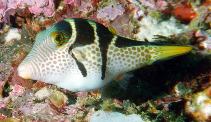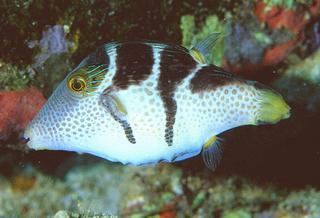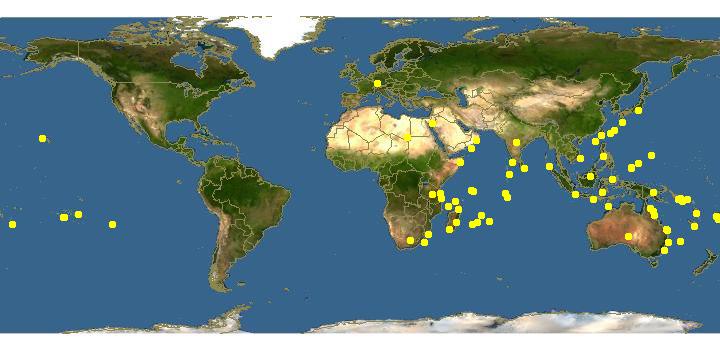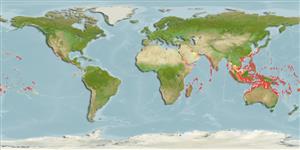|
| Links |
We parsed the following live from the Web into this page. Such content is managed by its original site and not cached on Discover Life. Please send feedback and corrections directly to the source. See original regarding copyrights and terms of use.
- Australian Faunal Directory
- FishBase
|
|
espa˝ol |
|
|
Overview |
Main identification features
- white, 2 black saddles, 2 black bars
Snout long and pointed; 1 pair of small hole-like nostrils; back with crest between eyes and dorsal fin; gill opening short, before upper edge of pectoral fin; dorsal 9 rays; anal 9 rays; pectoral 16-17 rays.
Whitish; small brown spots on sides of body and head; blue lines extend to rear from eye; dark brown saddle immediately behind eye, 2 long brown bars on body, dark brown saddle on tail base; tail fin yellow, upper and lower edges black.
Size: 11 cm.
Habitat: reefs.
Depth: 1-55 m.
Indo-Pacific; vagrant in the Galapagos.
Attributes
Abundance: Common.
Cites: Not listed.
Climate Zone: Equatorial (Costa Rica to Ecuador + Galapagos, Clipperton, Cocos, Malpelo).
Depth Range Max: 55 m.
Depth Range Min: 1 m.
Diet: sessile molluscs; soft corals/hydroids; sessile crustacea; sessile worms; benthic microalgae; sponges/seasquirts/bryozoa; sea-stars/cucumbers/urchins.
Eastern Pacific Range: Northern limit=2; Southern limit=-2; Western limit=-93; Eastern limit=-90; Latitudinal range=4; Longitudinal range=3.
Egg Type: Benthic; Pelagic larva.
Feeding Group: Omnivore.
FishBase Habitat: Reef Associated.
Global Endemism: All Pacific (West + Central + East); Indo-Pacific only (Indian + Pacific Oceans); TEP non-endemic; "Transpacific" (East + Central &/or West Pacific); All species.
Habitat: Corals; Reef associated (reef + edges-water column & soft bottom); Rocks; Reef (rock &/or coral); Reef only.
Inshore Offshore: Inshore; Inshore Only.
IUCN Red List: Not evaluated / Listed.
Length Max: 11 cm.
Regional Endemism: Island (s) only; Island (s); Tropical Eastern Pacific (TEP) non-endemic; Eastern Pacific non-endemic; All species.
Residency: Vagrant.
Salinity: Marine; Marine Only.
Water Column Position: Bottom; Bottom only;
|
|
|
Names | |
|
|
|
Links to other sites | |
|
|
|
References |
- Bleeker,., 1853., Derde bijdrage tot de kennis der ichthyologische fauna van Amboina., Natuurkd. Tijdschr. Neder. IndiŰ, 4:91-130.
- Grove , J.S. and Lavenberg, R. J., 1997., The fishes of the Galßpagos islands., Stanford University Press:863 pp.
- Smith , M. M. and Heemstra, P., 1986., Smith's Sea Fishes. Johannesburg: Macmillan South Africa. 1047 pp., Macmillan South Africa:1047pp.
|
|
|
Acknowledgements | |
I thank Ashley MacDonald and John Pickering, University of Georgia, for technical support in building this page.
|
|
| Supported by | |
|
Following modified from Australian Faunal Directory
|
Top | See original
| &pull 20q v5.145 20180528: Error 301 Moved Permanently http://biodiversity.org.au/afd/taxa/09248585-cca0-4b44-9311-acc7e45279e5 |
|
Following modified from FishBase
|
Top | See original
http://www.fishbase.org/Summary/speciesSummary.php?genusname=Canthigaster&speciesname=valentini ---> http://192.134.151.83/Summary/speciesSummary.php?genusname=Canthigaster&speciesname=valentini
http://192.134.151.83/Summary/speciesSummary.php?genusname=Canthigaster&speciesname=valentini ---> https://fishbase.mnhn.fr/Summary/speciesSummary.php?genusname=Canthigaster&speciesname=valentini
https://fishbase.mnhn.fr/Summary/speciesSummary.php?genusname=Canthigaster&speciesname=valentini ---> https://fishbase.mnhn.fr/summary/Canthigaster-valentini.html
Canthigaster valentini, Valentin's sharpnose puffer : aquarium

You can
sponsor
this page
Common name (e.g. trout)
Genus + Species (e.g. Gadus morhua)
-

-
About this page
-
Languages
-
User feedbacks
-
Citation
-
Uploads
-
Related species
-


 Valentin's sharpnose puffer
Add your observation in
Fish Watcher
Upload your
photos
and
videos
Valentin's sharpnose puffer
Add your observation in
Fish Watcher
Upload your
photos
and
videos
Pictures
|
Videos |
Google image
 Canthigaster valentini
Canthigaster valentini
Picture by
Wilkie, M.
Teleostei (teleosts) >
Tetraodontiformes
(Puffers and filefishes) >
Tetraodontidae
(Puffers) > Canthigasterinae
Etymology:
Canthigaster:
Greek, kanthos = the outer or inner corner of the eye, where the lids meet, 1646 + Greek, gaster = stomach (Ref.
45335
)
;
valentini:
Presumably after Gabriel Gustav Valentin (P.Adamicka, pers.comm. 11/09).
.
More on author:
Bleeker
.
Environment: milieu / climate zone / depth range / distribution range
Ecology
Marine; reef-associated; depth range 1 - 55 m (Ref.
1602
). Tropical; 32°N - 32°S
Indo-Pacific: Red Sea south to Durban, South Africa (Ref.
4919
) and east to the Tuamoto Islands, north to southern Japan, south to Lord Howe Island.
Length at first maturity / Size / Weight / Age
Maturity: L
m
4.6
, range 4 - 5.4 cm
Max length : 11.0 cm TL male/unsexed; (Ref.
4919
)
Dorsal
spines
(total): 0;
Dorsal
soft rays
(total): 9;
Anal
spines
: 0;
Anal
soft rays
: 9. Side with two prominent dark bars extending to belly (Ref.
559
).
Found among coral heads and rocks of subtidal lagoon and seaward reefs (Ref.
4919
,
5503
). Common on coastal reefs at various depths. Mimic filefish, males are territorial and are often seen fighting (Ref.
48637
). Feed mainly on filamentous green and red algae, tunicates, and on smaller amounts of corals, bryozoans, polychaetes, echinoderms, mollusks, and brown and coralline red algae. Form shoals (10-100 or more) often with the filefish,
Paraluteres prionurus
(about 5% of shoal) mimicking
C. valentini
to protect it from predators (Ref.
4919
,
5503
). Territorial and haremic; males spawn with a different female each day (Ref.
9710
). One or more territories are occupied and defended each by a female where a single large male stands guard (Ref.
55082
). All sexually mature females are territorial females (Ref.
55082
). Demersal spawner (Ref.
35298
).
Oviparous (Ref.
205
). Social and mating systems of this species are based upon female territoriality where polygyny results from males defending females occupying a certain territory (female-defense polygyny) (Ref.
55082
). All sexually mature females are territorial females (Ref.
55082
). Neither parent guards the eggs which are laid in a nest located in the female's territory (Ref.
46142
). During breeding, territorial females perform the 'caudal flexing with swollen abdomen display' to signal courtship and readiness to spawn. The male acknowledges with no courtship or color displays but rather by visiting the sites frequently. The territorial female then begins pecking at the substrate in preparation for egg laying. The female initiates the spawning event by pressing her abdomen into the prepared site. The territorial male quickly lays his body across her caudal peduncle and both remained in this position for 5-10 sec. The male swims away after leaving the female beating her anal fin rapidly over the nest site to ensure fertilization of the eggs and to push the eggs deep into the algal substrate (Ref.
46142
). All territorial males spawn with territorial females, depriving the bachelor males of the chance to copulate which nevertheless don't interfere with the spawning between the territorial male and females (Ref.
46142
).
Myers, R.F.
, 1991. Micronesian reef fishes. Second Ed. Coral Graphics, Barrigada, Guam. 298 p. (Ref.
1602
)
IUCN Red List Status (Ref.
130435
)
Least Concern (LC)
; Date assessed:
08 June 2011
CITES
Not Evaluated
Not Evaluated
Threat to humans
Poisonous to eat (Ref.
4919
)
Human uses
Aquarium: commercial
FAO - Publication:
search
|
FishSource
|
More information
Countries
FAO areas
Ecosystems
Occurrences
Introductions
Stocks
Ecology
Diet
Food items
Food consumption
Ration
Common names
Synonyms
Metabolism
Predators
Ecotoxicology
Reproduction
Maturity
Spawning
Spawning aggregation
Fecundity
Eggs
Egg development
Age/Size
Growth
Length-weight
Length-length
Length-frequencies
Morphometrics
Morphology
Larvae
Larval dynamics
Recruitment
Abundance
BRUVS
References
Aquaculture
Aquaculture profile
Strains
Genetics
Electrophoreses
Heritability
Diseases
Processing
Nutrients
Mass conversion
Collaborators
Pictures
Stamps, Coins Misc.
Sounds
Ciguatera
Speed
Swim. type
Gill area
Otoliths
Brains
Vision
Tools
Bio-Quiz
|
E-book
|
Field guide
|
Length-frequency wizard
|
Life-history tool
|
Point map
|
Classification Tree
|
Catch-MSY
|
Special reports
Check for Aquarium maintenance
|
Check for Species Fact Sheets
|
Check for Aquaculture Fact Sheets
Download XML
Summary page
|
Point data
|
Common names
|
Photos
Internet sources
AFORO (otoliths)
|
Aquatic Commons
|
BHL
|
Cloffa
|
BOLDSystems
|
Websites from users
|
Check FishWatcher
|
CISTI
|
Catalog of Fishes
:
genus
,
species
|
DiscoverLife
|
DORIS
|
ECOTOX
| FAO - Publication:
search
|
Faunafri
|
Fishipedia
|
Fishtrace
| GenBank:
genome
,
nucleotide
|
GloBI
|
Google Books
|
Google Scholar
|
Google
| IGFA World Record |
MitoFish
|
National databases
|
Otolith Atlas of Taiwan Fishes
|
Public aquariums
|
PubMed
|
Reef Life Survey
| Socotra Atlas |
Tree of Life
| Wikipedia:
Go
,
Search
| World Records Freshwater Fishing |
Zoological Record
Estimates based on models
Preferred temperature (Ref.
123201
): 24.6 - 28.9, mean 27.6 °C (based on 846 cells).
Phylogenetic diversity index (Ref.
82804
): PD
50
= 0.5000 [Uniqueness, from 0.5 = low to 2.0 = high].
Bayesian length-weight: a=0.03388 (0.01902 - 0.06038), b=2.85 (2.69 - 3.01), in cm total length, based on LWR estimates for this species & Genus-body shape (Ref.
93245
).
Trophic level (Ref.
69278
): 2.8 ±0.30 se; based on food items.
Resilience (Ref.
120179
): Medium, minimum population doubling time 1.4 - 4.4 years (Fecundity = 400).
Fishing Vulnerability (Ref.
59153
): Low vulnerability (10 of 100).
Nutrients (Ref.
124155
): Calcium = 113 [51, 272] mg/100g; Iron = 1.05 [0.51, 2.51] mg/100g; Protein = 17.9 [15.7, 20.1] %; Omega3 = 0.13 [0.06, 0.26] g/100g; Selenium = 39.9 [18.9, 91.4] ╬╝g/100g; VitaminA = 47.6 [12.6, 189.6] ╬╝g/100g; Zinc = 1.85 [1.19, 2.80] mg/100g (wet weight);
Back to Search
Random Species
Back to Top
Accessed through:
Not available
FishBase mirror site :
localhost
Page last modified by :
mrius-barile
- 20 July 2016
Fatal error
: Uncaught ArgumentCountError: Too few arguments to function checkEcotox(), 1 passed in /var/www/html/summary/speciessummary.php on line 2304 and exactly 3 expected in /var/www/html/includes/speciessummary.lib.php:2579 Stack trace: #0 /var/www/html/summary/speciessummary.php(2304): checkEcotox() #1 {main} thrown in
/var/www/html/includes/speciessummary.lib.php
on line
2579
|
Updated: 2024-06-16 20:37:30 gmt
|







